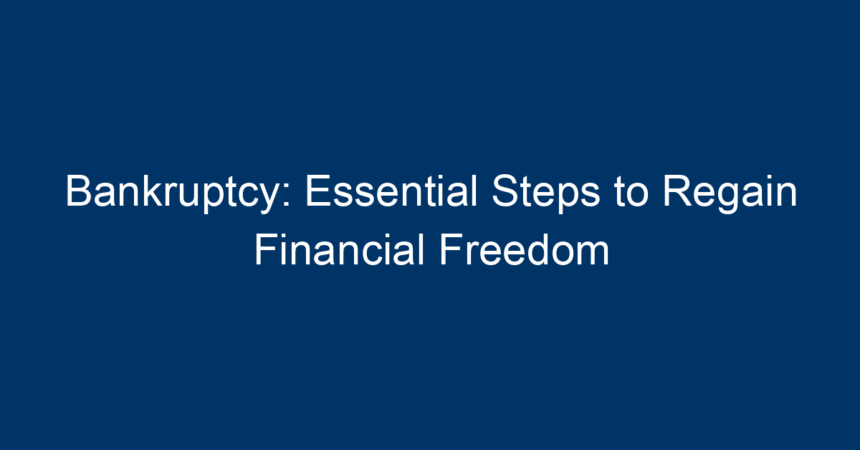Bankruptcy is often seen as a last resort, a final step when financial troubles feel insurmountable. However, understanding its nuances can provide you with a pathway to reclaim your financial stability and personal freedom. With the right approach, filing for bankruptcy can be a transformative experience, allowing individuals to rebuild their lives and secure a brighter financial future. This comprehensive guide will walk you through essential steps to take if you’re considering bankruptcy, empowering you to make informed decisions along the way.
Understanding Bankruptcy
Before diving into the steps to regain your financial freedom, it’s crucial to grasp what bankruptcy is. At its core, bankruptcy is a legal process that enables individuals and businesses to eliminate or repay their debts under the protection of the bankruptcy court. There are two primary types of consumer bankruptcy: Chapter 7 and Chapter 13, each catering to different financial situations.
Chapter 7 Bankruptcy
Chapter 7 bankruptcy, often referred to as “liquidation bankruptcy,” allows individuals to discharge most unsecured debts, such as credit card bills and medical expenses. It involves selling off non-exempt assets to repay creditors. This type of bankruptcy is usually completed within a few months, making it a quicker option for those in dire financial circumstances.
Chapter 13 Bankruptcy
Chapter 13, on the other hand, introduces a repayment plan that allows individuals to keep their assets while paying off a portion of their debts over three to five years. This option is suitable for those who have a steady income and want to avoid losing their property. Understanding these distinctions is vital to selecting the right bankruptcy option for your situation.
When to Consider Bankruptcy
Determining when to file for bankruptcy can be challenging. Here are some indicators that might suggest it’s time to consider this legal avenue:
- Excessive Debt: If your debts far exceed your income and monthly payments, bankruptcy may provide relief.
- Persistent Collection Calls: Continuous harassment from creditors can indicate that your financial situation is untenable.
- Risk of Foreclosure: If you’re facing foreclosure on your home, bankruptcy can halt proceedings and allow you time to organize your finances.
- Medical Bills: Unexpected medical expenses can quickly lead to overwhelming debt, making bankruptcy a viable option.
Preparing for Bankruptcy
Once you’ve decided that bankruptcy might be the right choice, preparation becomes crucial. Here are essential steps to take:
1. Gather Financial Documentation
Collecting all your financial documents is the first step. This includes:
- Bank statements
- Pay stubs
- Tax returns
- Bills
- Asset valuations
Having a comprehensive understanding of your financial situation will simplify the bankruptcy process.
2. Credit Counseling
Before filing for bankruptcy, you’re required to complete credit counseling from an approved agency. This session will help you explore alternatives to bankruptcy and understand the implications of proceeding with your case.
3. Create a Budget
While financial distress might have led you to consider bankruptcy, developing a budget will be crucial for your recovery post-bankruptcy. Track your income and expenses to understand your financial habits and identify areas for improvement.
Filing for Bankruptcy
Once prepared, the next step is to file for bankruptcy. Here’s a breakdown of what to expect:
1. Choose the Right Bankruptcy Type
Decide between Chapter 7 and Chapter 13 bankruptcy based on your needs and financial goals. Consulting with a bankruptcy attorney can provide invaluable insights into which option best suits your unique situation.
2. Complete Bankruptcy Forms
File the necessary forms with the court. These documents will provide a detailed account of your financial situation, including income, debts, and assets.
3. Attend the Meeting of Creditors
After filing, you will attend a meeting known as the 341 meeting, where your creditors have the opportunity to ask questions about your financial status. This is a standard procedure and typically brief if you’re organized.
4. Complete Required Financial Management Courses
Post-filing, you will also need to complete a financial management course. This will educate you on budgeting and managing finances, equipping you with skills for your financial future.
Life After Bankruptcy
Filing for bankruptcy is just the beginning of your journey toward financial recovery. Here are steps to take in the aftermath:
1. Rebuild Your Credit
The impact of bankruptcy can linger on your credit report for several years, but it’s not the end. Start rebuilding your credit by:
- Secured credit cards
- Timely bill payments
- Monitoring your credit report
Taking proactive steps will gradually improve your credit score.
2. Create a Financial Plan
Post-bankruptcy, developing a robust financial plan is crucial. This might include:
- Emergency Savings Fund: Aim to save at least three to six months’ worth of expenses.
- Debt Management: Avoid accruing new debt and focus on managing existing obligations.
- Long-term Goals: Set achievable financial goals, whether it’s saving for a home, retirement, or education.
3. Consider Professional Guidance
Working with a financial advisor can be beneficial during your recovery process. They can provide personalized strategies and long-term financial management tips suited to your needs.
Conclusion: Taking Charge of Your Financial Future
Bankruptcy is a powerful tool for those burdened by overwhelming debt. While it may seem daunting, understanding the process and taking deliberate steps can help you regain your financial freedom. Remember to seek professional advice and remain committed to rebuilding your financial health. The journey might be challenging, but with resilience and the right strategies, a brighter financial future awaits.
Empower yourself today! Take the first step by assessing your current financial situation and exploring the options available to you. It’s time to take charge of your financial narrative—freedom is within reach!




